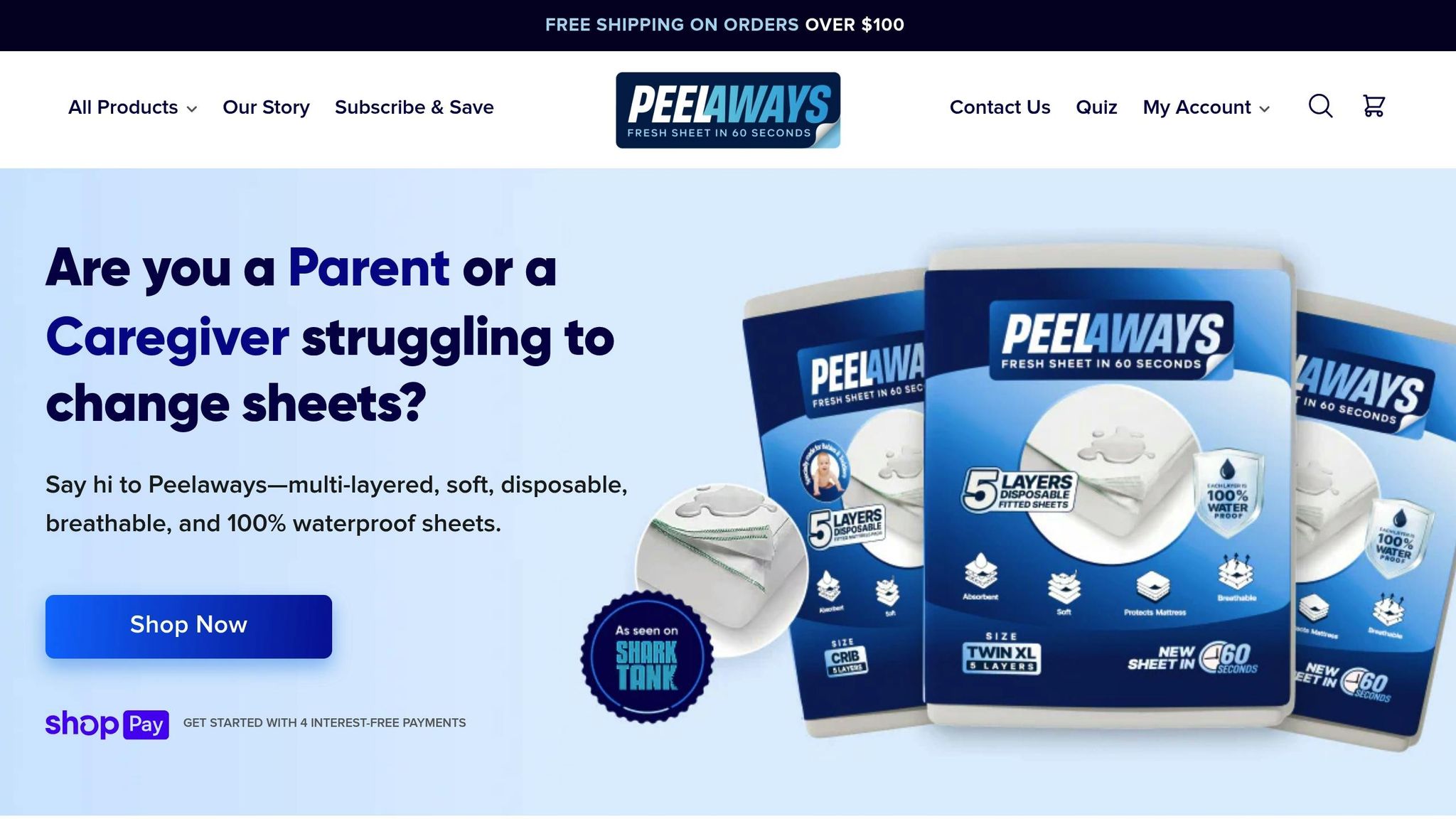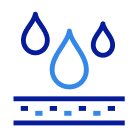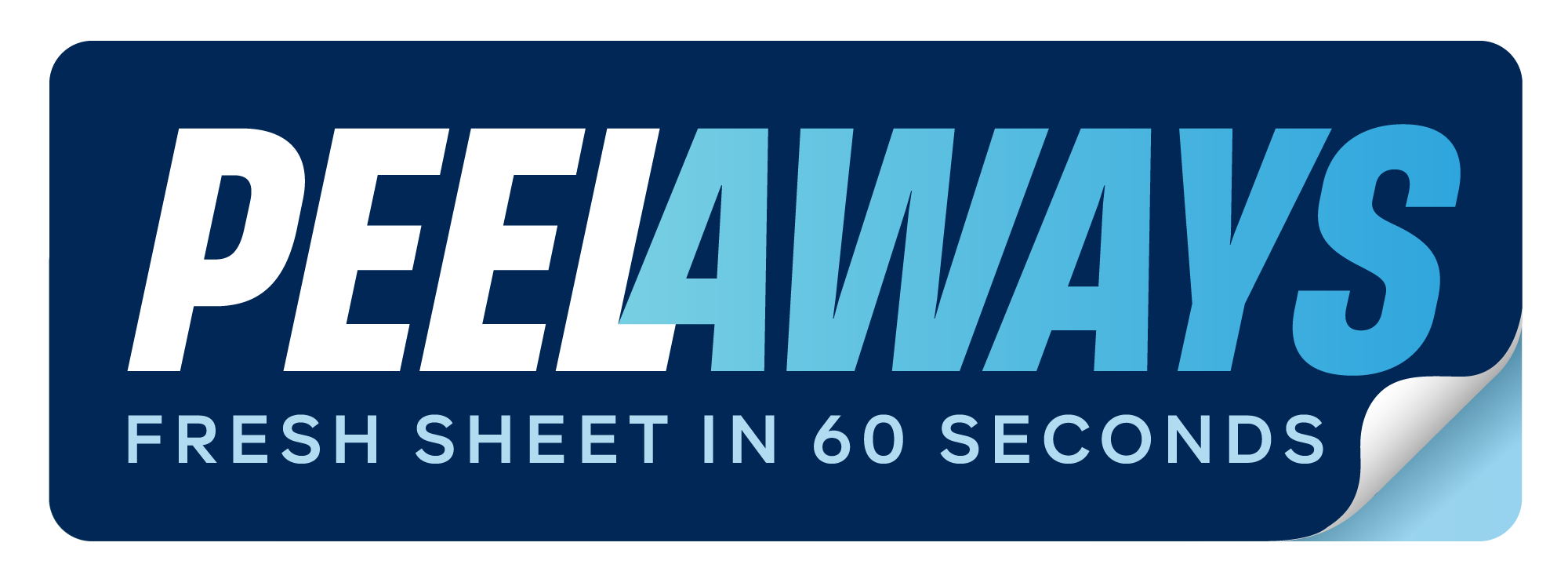How Moisture-Wicking Sheets Help Prevent Bed Sores

Moisture-wicking sheets are a practical solution for preventing bed sores, particularly in elder care. Bed sores, or pressure ulcers, form when prolonged pressure, friction, and moisture weaken the skin, leading to painful wounds. These sheets are designed to keep skin dry, reduce friction, and maintain airflow, protecting the skin's natural barrier. Here's how they work and why they matter:
- Moisture Control: Advanced fibers pull sweat and fluids away from the skin, allowing them to evaporate quickly, keeping the surface dry.
- Friction Reduction: Smooth, breathable fabrics minimize skin irritation caused by movement.
- Skin Protection: By maintaining ideal moisture levels, these sheets help preserve skin strength and elasticity.
- Convenience: Options like PeelAways offer disposable, multi-layered sheets, simplifying care and reducing laundry needs.
For elder care, moisture-wicking bedding is especially useful due to thinner skin, reduced mobility, and increased vulnerability to sores. Pairing these sheets with repositioning, pressure-relieving mattresses, and proper caregiver training can significantly lower the risk of bed sores while improving comfort and hygiene.
Bed Sores / Pressure Injuries: Prevention & Treatment - Ask A Nurse | @LevelUpRN
The Problem: How Moisture and Friction Cause Bed Sores
Let’s take a closer look at how the combination of moisture, friction, and pressure contributes to the development of bed sores. These factors work together to weaken the skin, making it prone to damage. Below, we’ll break down how moisture and friction specifically harm the skin.
How Excess Moisture Weakens the Skin
When there’s too much moisture, the skin’s natural protective barrier begins to break down. This leaves the skin more exposed to damage, especially when pressure and friction are involved. Once the skin is compromised, it starts a harmful cycle where it becomes increasingly vulnerable to further injury.
Friction and Pressure: Key Contributors to Bed Sores
Friction happens when the skin rubs against surfaces like bedsheets. Even small amounts of friction, when combined with pressure, can harm sensitive skin. Pressure, as mentioned earlier, reduces blood flow and can damage tissue in as little as two hours [1]. Bed sores often form in areas where bones are close to the surface, such as the tailbone, hips, and heels [1]. Additionally, traction - when the skin is stretched or pulled - raises the risk even more [1]. People with thinner skin or limited mobility face an even higher likelihood of developing these sores [1].
The Solution: How Moisture-Wicking Sheets Help
Now that we've covered how moisture and friction can create the perfect storm for bed sores, let's dive into how moisture-wicking sheets can disrupt this harmful cycle. These specialized sheets help keep skin dry and reduce friction - two critical factors in preventing skin damage. Below, we’ll explore their medical benefits and why they’re especially useful in elder care.
How Moisture-Wicking Fabrics Work
Moisture-wicking fabrics are designed with advanced fibers that draw moisture away from the skin. These fibers channel sweat and other fluids through microscopic pathways in the material, moving them to the fabric's outer surface where they evaporate quickly. This process keeps the skin dry, improves airflow, and helps regulate body temperature. By reducing heat and humidity, these fabrics protect the skin’s integrity, maintaining its natural barrier and making it more resistant to pressure and friction.
Medical Benefits for Bed Sore Prevention
Moisture-wicking sheets do more than just keep you comfortable - they actively support skin health. By keeping the skin at an ideal moisture level, these sheets help maintain its natural pH balance and oils, which are essential for elasticity and strength. Skin that is neither too dry nor too damp is less likely to break down under pressure. Additionally, the smooth, dry surface reduces friction during movement, lowering the risk of skin tears or irritation that could escalate into bed sores.
Why These Sheets Work Well for Elder Care
Elder care often comes with unique challenges, making moisture-wicking sheets a game-changer. Seniors are more vulnerable to bed sores due to thinner skin, reduced circulation, and extended periods of immobility. Damp bedding from sweating, incontinence, or medical treatments can quickly lead to skin damage. Moisture-wicking sheets combat this by providing a consistently dry surface, reducing skin irritation and the need for frequent sheet changes. Plus, they enhance comfort, which can improve sleep quality - an essential factor in overall health and recovery.
PeelAways offers an innovative solution for elder care with their disposable, waterproof bed sheets. These sheets feature a patented multi-layer design, with 5 to 7 absorbent layers depending on the size. When the top layer becomes soiled, caregivers can simply peel it away to reveal a fresh, clean layer underneath. This eliminates the need for heavy lifting, cuts down on laundry, and prevents cross-contamination, making it an efficient and practical choice for busy care settings.
Next, we’ll explore the key features to consider when choosing moisture-wicking bedding.
sbb-itb-45288fe
What to Look for in Moisture-Wicking Bedding
When choosing moisture-wicking bedding, it’s essential to focus on four key factors: moisture control, comfort, safety, and ease of maintenance. The best bedding not only manages moisture effectively but also ensures comfort, promotes safety, and simplifies caregiving routines. These features can enhance skin health while making daily care tasks more efficient.
Material Types and Comfort Features
The foundation of moisture-wicking bedding lies in its material. Synthetic blends, like polyester-cotton combinations, use advanced fibers to create tiny pathways for quick moisture transfer, all while maintaining a soft texture. Bamboo-derived fabrics are another excellent choice, offering natural moisture-wicking properties, a silky smooth feel, and built-in antimicrobial benefits. Microfiber materials, known for their durability, hold up well after repeated washes, making them ideal for high-use settings such as elder care facilities.
Temperature regulation is another crucial factor. Look for breathable weaves that encourage airflow without compromising moisture control. Instead of focusing solely on thread count, prioritize fiber quality - sheets with a thread count between 200 and 400 often strike the best balance between softness and breathability.
Anti-Microbial and Hypoallergenic Features
Safety is just as important as comfort, especially in elder care settings. Bedding with antimicrobial properties can help protect against harmful microorganisms. Many modern fabrics incorporate treatments like silver-ion technology, which provides ongoing protection against bacteria, fungi, and odor-causing microbes, even after multiple washes.
Hypoallergenic bedding is also critical for minimizing allergic reactions or skin sensitivities. Look for products free from common irritants like latex and formaldehyde, and those that meet certifications such as OEKO-TEX Standard 100. Whenever possible, opt for fabrics that naturally manage moisture without relying on chemical treatments, which can wear off over time or trigger skin reactions.
Easy Care and Maintenance
In care environments, ease of maintenance is a must. Machine-washable bedding that can withstand hot water (around 140°F or higher) ensures proper sanitization without losing its effectiveness. Quick-drying fabrics, whether air-dried in a few hours or tumble-dried on low heat, can help reduce laundry turnaround time. Additional features like stain resistance, wrinkle resistance, and easy spot-cleaning also minimize extra effort for caregivers.
Introducing PeelAways: A New Bedding Option

For a practical solution that meets these criteria, PeelAways offers an innovative option. These disposable, waterproof sheets feature a patented multi-layer design. When the top layer becomes soiled, caregivers can simply peel it away to reveal a fresh, clean layer underneath. This eliminates the need for lifting mattresses, reduces laundry demands, and minimizes the risk of cross-contamination.
PeelAways sheets are both 100% waterproof and breathable, providing moisture protection while remaining comfortable and gentle on the skin. They come in a variety of sizes, from Crib-A-Peel for infants to Twin XL options with seven layers for high-demand scenarios, as well as standard sizes like Twin, Full, Queen, and King, each with multiple absorbent layers.
Additionally, these sheets are designed with sensitive skin in mind and are available in compostable, biodegradable options, addressing environmental concerns. This combination of practicality, safety, and sustainability makes PeelAways an excellent choice for elder care facilities aiming to balance patient care with operational efficiency.
How to Use Moisture-Wicking Bedding in Elder Care
Moisture-wicking bedding offers a practical solution for improving comfort and care in elder care settings. To make the most of its benefits, caregivers need clear protocols and proper training. Here’s how to effectively integrate moisture-wicking bedding into elder care routines.
Setting Up a Bedding Care Schedule
Establishing a consistent bedding care schedule is crucial. For traditional sheets, plan to change them every 48–72 hours or immediately if soiled. Keep spare bedding sets within easy reach and document every change, noting any observations about the resident’s skin condition.
For a more efficient solution, consider using PeelAways. These sheets allow caregivers to peel away a soiled layer to reveal a clean one underneath, minimizing physical strain and handling. With 5–7 layers per sheet, they can last for days without requiring laundering.
Adjust this schedule based on room conditions. For example, in rooms where temperatures exceed 75°F, perspiration levels may rise, necessitating more frequent changes - even with high-quality moisture-wicking bedding. Monitoring humidity levels and tailoring the schedule is especially important for residents whose medications or health conditions cause excessive sweating. Once a bedding schedule is in place, combine it with other measures to help prevent bed sores.
Using Bedding with Other Bed Sore Prevention Methods
Moisture-wicking bedding works best when paired with other strategies, such as pressure-relieving mattresses and repositioning residents every two hours. Applying skin barrier creams, like zinc oxide, before placing the bedding can further protect against friction and moisture-related damage.
For residents with incontinence, layering waterproof pads or PeelAways sheets directly on the mattress, followed by a moisture-wicking top sheet, helps manage heavy moisture while keeping the surface gentle on the skin. The breathable yet waterproof design of PeelAways often eliminates the need for additional protective layers.
Additionally, proper nutrition and hydration play a key role in maintaining skin health. Collaborating with dietary staff to ensure residents receive the nutrients they need can enhance the overall effectiveness of these bedding practices.
Teaching Caregivers About Bedding Management
Educating caregivers is essential for consistent and effective bedding management. Training should include instructions on how to properly install sheets to avoid creating pressure points that could harm residents’ skin.
Caregivers should also learn to identify early signs of moisture-related skin damage, such as redness, maceration, or unusual warmth. Using visual aids that compare healthy skin to early damage signs can help improve assessment skills.
Demonstrate the peel-away technique for PeelAways so caregivers can remove soiled layers without disturbing residents. Encourage them to document bedding changes and note any skin issues or moisture concerns. This information can help identify patterns and guide adjustments to care plans.
It’s also important to address misconceptions. Some caregivers may believe that waterproof bedding is uncomfortable, but modern materials like those in PeelAways are both breathable and protective. Providing quick reference guides with care instructions, change schedules, and troubleshooting tips can further support caregivers. Regular refresher sessions can reinforce these practices, ensuring consistent care and better outcomes for residents.
Conclusion: Better Elder Care with Moisture-Wicking Sheets
Moisture-wicking bedding offers a practical way to help prevent bed sores while enhancing comfort for elderly residents. These specialized sheets work by pulling moisture away from the skin and minimizing friction - two key factors in reducing the risk of pressure ulcers.
In addition to protecting the skin, these sheets ease the workload for caregivers by cutting down on frequent bedding changes. They also contribute to better sleep quality for residents. When combined with regular repositioning and proper caregiver training, the risk of bed sores can be significantly reduced.
A great example of this solution is PeelAways. PeelAways uses moisture-wicking technology in its waterproof yet breathable sheets, which eliminate the need for constant laundering while maintaining top-notch hygiene standards. With prices ranging from $30.99 for Crib-A-Peel to $53.99 for King sizes, along with perks like a 15% subscription discount and a 30-day money-back guarantee, PeelAways provides an affordable and efficient option for elder care bedding.
Incorporating moisture-wicking bedding into elder care routines goes beyond bed sore prevention - it’s about improving the overall quality of care. Keeping residents dry, comfortable, and free from skin irritation enhances their health and well-being. For caregivers, this means less time spent managing bedding and more time to focus on other critical aspects of care.
FAQs
What makes moisture-wicking sheets better than traditional sheets for preventing bed sores?
Moisture-wicking sheets are specially crafted to keep the skin dry by drawing moisture away and allowing better airflow. This feature is particularly beneficial for individuals who are immobile or spend extended periods in bed, as it helps reduce skin irritation, friction, and the chances of developing bed sores.
Traditional sheets often trap moisture and heat, which can lead to discomfort and skin issues. In contrast, moisture-wicking sheets help regulate body temperature and reduce sweating. This creates a cooler, cleaner, and more comfortable environment - key factors in preventing pressure ulcers and supporting skin health, especially in elderly care settings.
What makes moisture-wicking sheets a great choice for elder care?
Moisture-wicking sheets are an excellent option for elder care because they draw moisture away from the skin and dry quickly. This helps prevent dampness, which can lead to skin irritation or even bed sores. Additionally, these sheets improve airflow, keeping the skin cool and comfortable - an essential feature for individuals who spend long periods in bed.
Peelaways offers a clever solution with their disposable, multi-layered bed sheets. Each sheet includes 5 to 7 soft, absorbent layers. When the top layer becomes soiled, you simply peel it off to reveal a fresh, clean layer underneath. This eliminates the hassle of lifting mattresses or doing laundry and minimizes the risk of cross-contamination, making them a practical choice for elder care and recovery after medical procedures.
How can caregivers use moisture-wicking sheets to help prevent bed sores?
Caregivers can get the best results from moisture-wicking sheets by making them a key part of daily care routines. These sheets are specially designed to pull moisture away from the skin, helping to create a drier, more breathable surface that can reduce the risk of bed sores and skin irritation.
To boost their effectiveness, combine the use of moisture-wicking sheets with regular repositioning to ease pressure on sensitive areas. Adding frequent skin checks and absorbent pads into the routine can further improve dryness and overall comfort. These straightforward practices can play an important role in maintaining skin health, particularly in elderly care settings.
Related Blog Posts
- Bedding Care Checklist for Healthcare Facilities
- 7 Tips for Preventing Skin Irritation from Incontinence
- How to Choose Bedding for Incontinence Care
- Preventing Odors in Incontinence Bedding: Tips and Tricks
Comments
0

SAVE MONEY & WATER
Professionals & Institutions save a fortune on labor/laundry.

SUPERIOR COMFORT
The first thing our customers notice is how soft our sheets are.

100% WATERPROOF
Each layer is 100% Waterproof, perfect for spills and accidents

SAVE TIME
Change the sheet in under 1 minute without stripping the bed.




Leave a comment